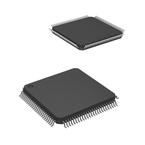● High-Performance Static CMOS Technology
● TMS470R1x 16/32-Bit RISC Core (ARM7TDMI™)
● 24-MHz System Clock (48-MHz Pipeline)
● Independent 16/32-Bit Instruction Set
● Open Architecture With Third-Party Support
● Built-In Debug Module
● Integrated Memory
● 288K-Byte Program Flash
● Two Banks With 8 Contiguous Sectors
● 16K-Byte Static RAM (SRAM)
● Memory Security Module (MSM)
● JTAG Security Module
● Operating Features
● Low-Power Modes: STANDBY and HALT
● Extended Industrial Temperature Range
● 470+ System Module
● 32-Bit Address Space Decoding
● Bus Supervision for Memory/Peripherals
● Digital Watchdog (DWD) Timer
● Analog Watchdog (AWD) Timer
● Enhanced Real-Time Interrupt (RTI)
● Interrupt Expansion Module (IEM)
● System Integrity and Failure Detection
● ICE Breaker
● Direct Memory Access (DMA) Controller
● 32 Control Packets and 16 Channels
● Zero-Pin Phase-Locked Loop (ZPLL)-Based Clock Module With Prescaler
● Multiply-by-8 Internal ZPLL Option
● ZPLL Bypass Mode
● High-End Timer Lite (HET)
● 12 Programmable I/O Channels: 12 High-Resolution Pins
● High-Resolution Share Feature (XOR)
● High-End Timer RAM 64-Instruction Capacity
● External Clock Prescale (ECP) Module
● Programmable Low-Frequency External Clock (CLK)
● Ten Communication Interfaces:
● Two Serial Peripheral Interfaces (SPIs)
● 255 Programmable Baud Rates
● Two Serial Communication Interfaces (SCIs)
● 224 Selectable Baud Rates
● Asynchronous/Isosynchronous Modes
● Class II Serial Interface B (C2SIb)
● Normal 10.4 Kbps and 4X Mode 41.6 Kbps
● Two Standard CAN Controllers (SCC)
● 16-Mailbox Capacity
● Fully Compliant With CAN Protocol, Version 2.0B
● Three Inter-Integrated Circuit (I2C) Modules
● Multi-Master and Slave Interfaces
● Up to 400 Kbps (Fast Mode)
● 7- and 10-Bit Address Capability
● 12-Channel 10-Bit Multi-Buffered ADC (MibADC)
● 64-Word FIFO Buffer
● Single- or Continuous-Conversion Modes
● 1.55 µsMinimum Sample/Conversion Time
● Calibration Mode and Self-Test Features
● Flexible Interrupt Handling
● Expansion Bus Module (EBM) (PGE only)
● Supports 8- and 16-Bit Expansion Bus Memory Interface Mappings
● 42 I/O Expansion Bus Pins
● 50 Dedicated General-Purpose I/O (GIO) Pins and 43 Additional Peripheral I/Os (PGE)
● 14 Dedicated General-Purpose I/O (GIO) Pins and 43 Additional Peripheral I/Os (PZ)
● 16 External Interrupts
● On-Chip Scan-Base Emulation Logic, IEEE Standard 1149.1(1) (JTAG) Test-Access Port
● 144-Pin Plastic Low-Profile Quad Flatpack (PGE Suffix)
● 100-Pin Plastic Low-Profile Quad Flatpack (PZ Suffix)

 Part 3D Model
Part 3D Model
